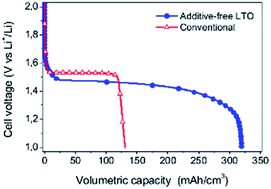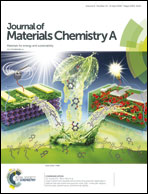Additive-free Li4Ti5O12 thick electrodes for Li-ion batteries with high electrochemical performance†
Abstract
The Li4Ti5O12 (LTO) spinel is one of the most promising negative electrode materials for safe Li-ion batteries. We here present a powerful and easily scalable method to produce additive-free LTO ceramic anodes with thickness as high as 500 μm (ca. 140 mg cm−2) with outstanding electrochemical performance. The anodes are produced by powder extrusion moulding (PEM) that employs, temporarily, thermoplastic binders. The controlled removal of the binder allows leaving a very thin percolating carbon coating that provides suitable electrical conductivity to obtain good electrochemical performance. The absence of additives in the electrodes makes them safer than conventional electrodes and maximizes the active powder content per volume unit. As a direct consequence of this latter feature, the volumetric discharge capacity of the LTO-ceramic anode (Q = 319 mA h cm−3 at C/24) is almost three times higher than that of the LTO-control composite electrode (131 mA h cm−3) prepared by conventional casting. This result is explained by the higher density of LTO-ceramic and its additive-free nature. Moreover, due to the absence of additives and especially due to the very high thickness of our LTO-ceramic anode, the areal capacity (15.2 mA h cm−2) exceeds by more than one order of magnitude that of the LTO-control electrode. Besides, this ceramic anode, made up of only the active material, exhibits high cyclability, being able to retain more than 95% of its nominal capacity after 20 cycles of charge–discharge at C/24, C/12 and C/8 rates.



 Please wait while we load your content...
Please wait while we load your content...